St. Louis Baby Tooth Study: Newsletter 2
Hello again!
A lot has happened since the first issue of our Newsletter—there are now over 5,000 of you who have completed Survey/Cognitive Test 1. Plus over 3,000 of you have completed Survey/Cognitive Test 2. THANK YOU so much to all who have participated! This research could not happen without you.
Enrollment for Survey/Cognitive Test 1 is closing soon, but there is still time to participate! We will also send more invitations for Survey/Cognitive Test 2. If you have not participated yet, please keep your eyes open for our invitation. Or, if you already have one of our invitations handy and know your study ID #, please click here to our study surveys page and participate now!
We also invited about 1,000 of you to participate in Phase II of the study, which involved providing samples of blood, toenails, and household water to better understand the relationship between environmental exposures and health. These invitations were selected randomly, so please don’t feel bad if you didn’t get one.
Preliminary Results
In Your Baby Teeth
We have been hard at work studying the data you provided, including some of the teeth you gave all of those years ago. Only a small percentage of those thousands of teeth have been examined, but below are some of the results. Each dot on the figure is one of you. This is what was in your body when you were in the womb (and just after you were born)!

Lead amounts are fairly consistent both before and after birth.
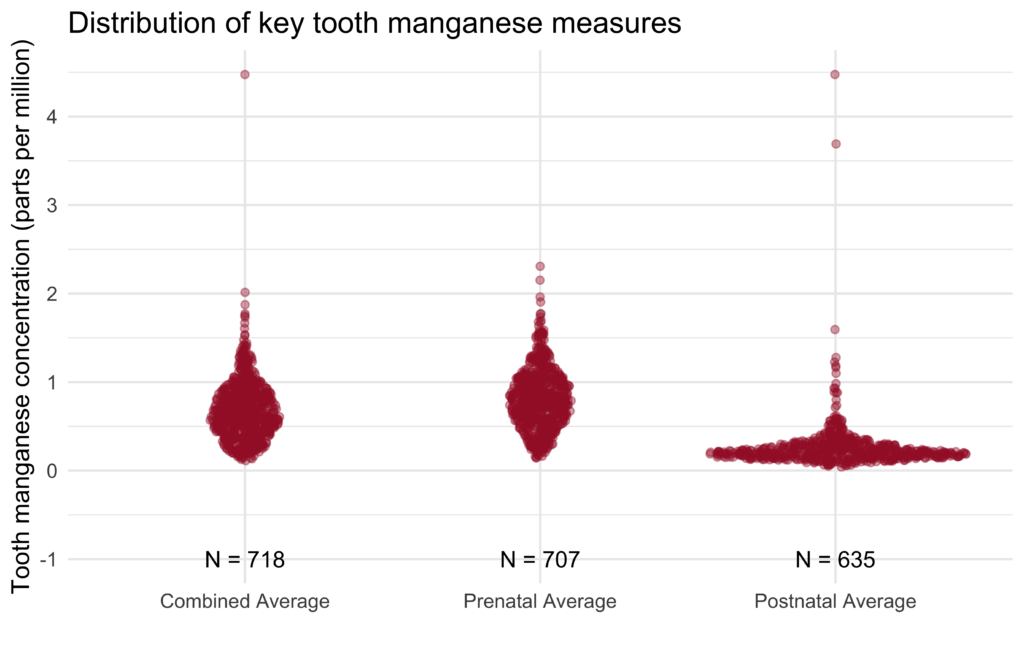
Manganese is a nutrient that the body needs, but levels that are too low or too high could cause some health problems. Manganese amounts in the teeth are lower in the postnatal period (that is, following birth)—this is exactly what normally happens, as manganese is especially important as the fetus develops.
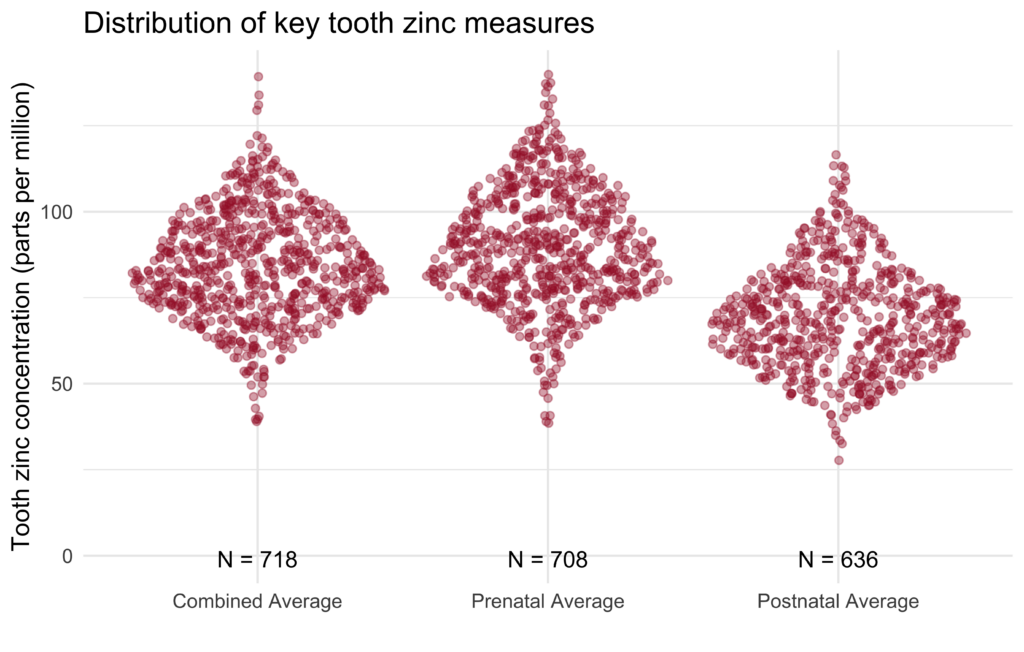
Zinc is also a critical nutrient that the body needs and you can see that levels are much higher than lead or manganese. There is a wide distribution of levels among you and, a little like with manganese, the amounts are a bit lower after birth than before.
Your Baby Teeth Compared to Other Studies
What we generally see from around the time of your birth is that metals levels are not the same for all of you. This is to be expected. We have also compared these and other metals levels to those we see in present day groups in New Hampshire and in Nigeria. This data was published in this paper:
Punshon, T., Bauer, J.A., Karagas, M.R. et al. Quantified retrospective biomonitoring of fetal and infant elemental exposure using LA-ICP-MS analysis of deciduous dentin in three contrasting human cohorts. J Expo Sci Environ Epidemiol 34, 1000–1011 (2024).
https://www.nature.com/articles/s41370-024-00652-3
The paper asked the question: Can the use of “absolute quantification” (which means making raw data easier to compare) allow accurate comparisons between different studies? The answer was: yes! This is an important contribution because if researchers use this approach, it makes comparisons across studies much more reliable and enriches the scientific value of the data.
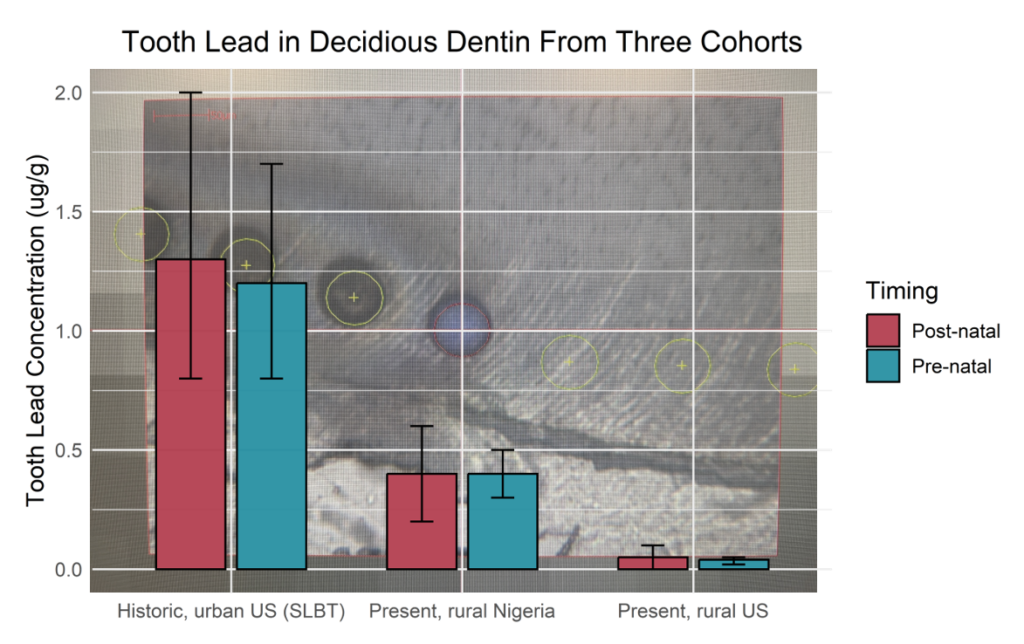
The comparison for lead between the three populations is shown below. The teeth from the SLBT study showed, unfortunately but unsurprisingly, much higher lead levels due to many factors of the time period when they were collected (for example: leaded gasoline and lead paint were common, water safety and food safety effort were uncommon, and mining practices were less concerned with environmental impact).
In Your Cognitive Data
We also have data on the cognitive tests you’ve been completing. Just as a quick look we combined all your test score into one summary score. Here is a look at the distribution of that score in four different age groups. What you can see is that the distribution of scores shifts a little lower in the older age groups—this is normal with aging! But there is still a wide variation and a lot of overlap!
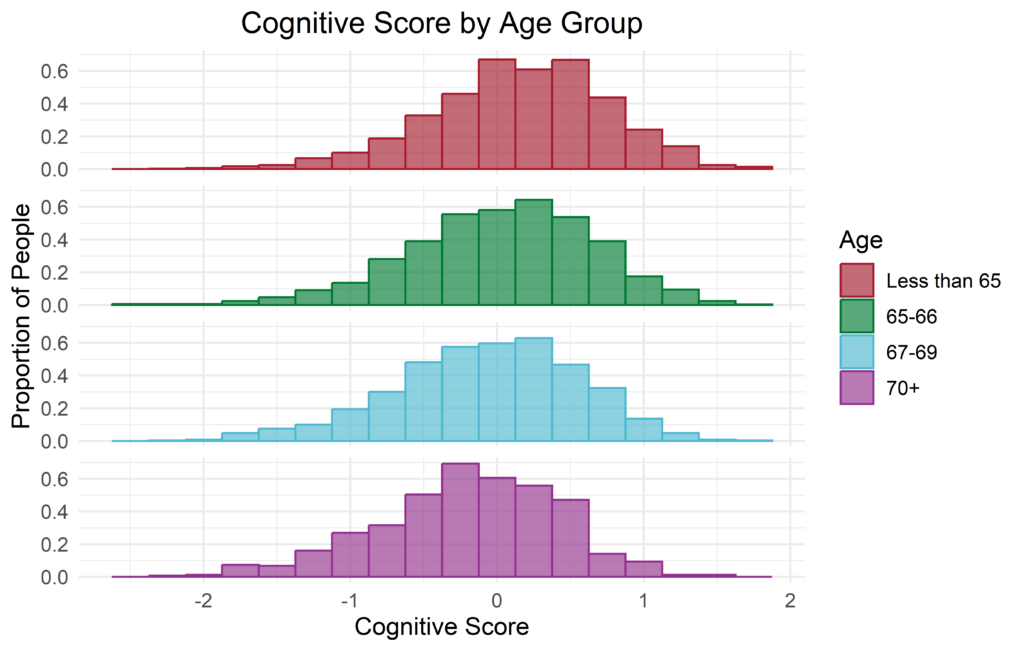
Since the analysis of tooth metal takes a lot of time, we have also continued to look at your survey results. We published the following new report this year:
Roberts AL, Qiu X, McAlaine KA, Germine LT, Rotem RS, Weisskopf MG. Early-life cognitively stimulating activities and late-life cognitive function in the St. Louis Baby Tooth Later Life Health Study. Scientific Reports. 2025/01/15 2025;15(1):2105.
https://www.nature.com/articles/s41598-024-79083-x
This paper looked at how activities that engaged the brain during childhood—like playing board games, reading, writing, and doing homework—might benefit cognitive abilities (which means the mental process involved in knowing, learning, and understanding things)later in life. When we combined the cognitive results across all the tests into one measure, the results showed that study members who engaged more in cognitively-stimulating activities as children generally had better overall cognitive performance in later life. Interestingly, when we looked more closely at the age that seemed to matter most for these benefits, only activities at age 18 had a significant link to better cognitive health in older age (see figure below). Also, the benefits were most noticeable for those who had fewer of these activities during their late teens – the difference between doing no activities and doing a few activities was associated with much better cognitive outcomes, while there was a smaller difference between doing a high vs. medium amount of activities.
Our study suggests that encouraging mentally stimulating activities, especially during the late teen years, could be beneficial for long-term cognitive health, especially for teens who may have limited access to such activities.
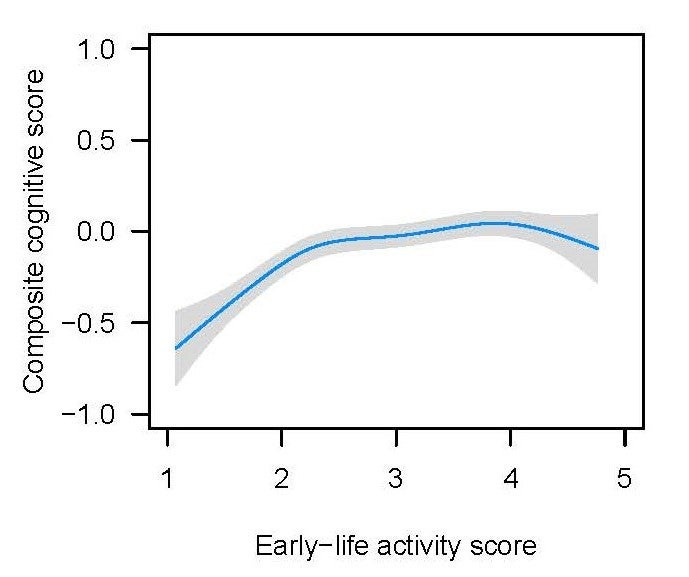
Figure. This figure shows the relationship between cognitively stimulating activities at age 18 and cognitive scores in later life. The blue line represents the estimated relationship with cognitive scores, and the grey band around it shows how uncertain that estimate is— a wider band means less certainty. Generally, people with fewer activities at age 18 (a score of 1 or 2) had worse cognitive functioning in later life, although these differences were most clear at the lower levels of activities. The cognitive scores are standardized, meaning the average score among everyone at 0, and scores worse than that are negative and scores better than that are positive.
Thank you again for participating!
SLBT In the News/In the Community
The National Endowment for the Humanities awarded its special prize for “Untold Stories in History” to Missouri high school student Rohan Deshpande. His 2024 NHD (National History Day) project was a documentary on the St. Louis Baby Tooth Survey.
Fox2, the St. Louis TV station, ran a story on the tooth study. Their website, Fox2Now, also ran an article called, “The lasting impact of the baby tooth project in St. Louis”
Marc Weisskopf, head of the SLBT study, gave a talk called “Exploring early origins of cognitive decline: The St. Louis Baby Teeth Study” at the University of Michigan Center on Lifestage Environmental Exposures and Disease (M-LEEaD) Integrated Health Sciences Core on March 23, 2023.
What’s Next
As we mentioned above, enrollment is still underway for Survey/Cognitive Test 1 and Survey/Cognitive Test 2. Please keep your eyes open for our email and U.S. mail invitations.
We want to keep you updated on our progress through these newsletters. Plus, it gives us another chance to say thanks for your important contributions to this research! In future newsletters, we will share further details from published results, highlight key researchers, and let you know what happens next.
Many of your questions will be answered by going to hsph.me/slbt and selecting “FAQ.” But if you want to contact the study team, you can reach us at slbt@hsph.harvard.edu (fastest response time) or 617-432-0041 with any questions.
Our sincere thanks,
SLBT Study Team
Dr. Marc G. Weisskopf